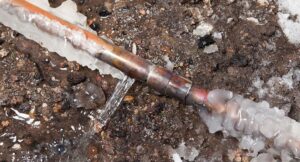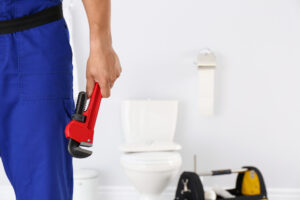Plumbing systems are built to handle day-to-day water usage, but weather conditions can introduce additional challenges. Extreme temperatures, heavy rainfall, or severe storms can all impact the efficiency and integrity of your plumbing. Whether it’s freezing temperatures in the winter or high humidity during the summer, understanding how weather can affect your plumbing system is crucial in preventing damage and ensuring everything works as it should.
Impact of Cold Weather on Plumbing
 Cold weather is one of the most significant factors that can affect your plumbing system, especially in regions that experience freezing temperatures. When water freezes, it expands, and this can cause pipes to burst or crack. This is particularly problematic for exposed pipes, such as those in uninsulated attics, basements, or crawl spaces. Even pipes that are buried underground can be vulnerable in extreme cold.
Cold weather is one of the most significant factors that can affect your plumbing system, especially in regions that experience freezing temperatures. When water freezes, it expands, and this can cause pipes to burst or crack. This is particularly problematic for exposed pipes, such as those in uninsulated attics, basements, or crawl spaces. Even pipes that are buried underground can be vulnerable in extreme cold.
Frozen pipes can result in costly repairs and major disruptions. If a frozen pipe bursts, it can lead to water damage inside your home, potentially ruining floors, walls, and personal belongings. To prevent such issues, it’s important to insulate vulnerable pipes and ensure that your home is properly sealed against the cold. Regularly checking pipes and turning on faucets in colder months can help keep the water flowing, reducing the risk of freezing.
Effects of Hot Weather on Plumbing Systems
While cold weather can freeze pipes, extreme heat can have its own set of challenges for your plumbing. Hot weather can cause pipes to expand and contract. This constant expansion and contraction can weaken pipes over time, potentially causing leaks or cracks. In areas where water demand is high, particularly during the summer months, pipes can also become overworked, leading to increased pressure and the possibility of failures.
Hot temperatures can also lead to issues with water heaters. If your water heater is constantly in use during hot months, it may overheat and malfunction. To avoid these issues, it’s essential to ensure that your plumbing system is in good condition before the arrival of summer. Checking water pressure and inspecting for any signs of leaks or wear can help keep everything running smoothly.
Heavy Rainfall and Flooding: Risks for Your Plumbing System
Heavy rainfall can put significant pressure on your plumbing system. Excessive water runoff can overwhelm outdoor drainage systems, leading to flooding in your yard, basement, or crawl spaces. This flooding can not only cause damage to the structure of your home but can also affect your plumbing system. If water backs up into your home, it can cause pipes to become clogged or even burst.
Floodwaters can also introduce debris and contaminants into your plumbing, which can lead to serious health risks if not properly addressed. Additionally, the increased moisture can cause the pipes to rust or corrode over time, weakening their structure and reducing their lifespan. Installing sump pumps in vulnerable areas, ensuring proper grading around your home, and maintaining clear gutters and downspouts can help prevent floodwater from impacting your plumbing.
Humidity’s Role in Plumbing Efficiency
Humidity, which is often high in tropical or coastal regions, can also affect plumbing systems. The moisture in the air can contribute to the formation of mold and mildew, especially in areas where plumbing pipes are exposed or not well-ventilated. In extreme cases, mold growth can clog pipes or cause damage to insulation, which can result in a decrease in efficiency.
Excess moisture can also lead to rust, particularly on metal pipes. This rust can cause the water to flow more slowly and make it harder for your plumbing system to handle its regular workload. If you live in an area prone to high humidity, ensuring that your plumbing system is equipped with proper ventilation and moisture control can help maintain efficiency and extend the life of your pipes.
Storms and Extreme Weather Conditions
 In addition to temperature and humidity, extreme weather events such as hurricanes, tornadoes, or heavy thunderstorms can cause significant damage to your plumbing system. High winds can uproot trees, which can fall on pipes, damaging both underground and above-ground plumbing systems. Tornadoes and storms can create sudden pressure on water lines, causing leaks or breaks.
In addition to temperature and humidity, extreme weather events such as hurricanes, tornadoes, or heavy thunderstorms can cause significant damage to your plumbing system. High winds can uproot trees, which can fall on pipes, damaging both underground and above-ground plumbing systems. Tornadoes and storms can create sudden pressure on water lines, causing leaks or breaks.
In the aftermath of such storms, debris and sediment can clog drains, affecting the flow of wastewater and increasing the risk of pipe bursts. With the potential for power outages, it’s important to check the condition of your plumbing after a storm to ensure that everything is functioning properly. You should also consider having an emergency backup water system in place, such as a water tank or backup generator, to avoid disruptions in your plumbing services.
How to Protect Your Plumbing System from Weather-Related Issues
There are several steps you can take to safeguard your plumbing system from the various impacts of weather. First and foremost, regular inspections of your pipes, faucets, and water heaters are crucial in identifying any weak spots or areas that may require repair. Insulating exposed pipes is one of the most effective ways to prevent freezing during the winter, while checking for leaks and cracks during the summer can help you address any weaknesses before they turn into major problems.
For those who live in flood-prone areas, ensuring that you have functional sump pumps and proper drainage systems can prevent water damage. You should also make sure that your home’s foundation is sealed properly to prevent water from seeping into vulnerable areas where plumbing is located.
Another preventative measure involves keeping your plumbing system clean and clear of debris. Regularly flushing your drains and having a professional plumber inspect your system can help ensure that your pipes are free of blockages, which can become worse during periods of heavy rain or storms.